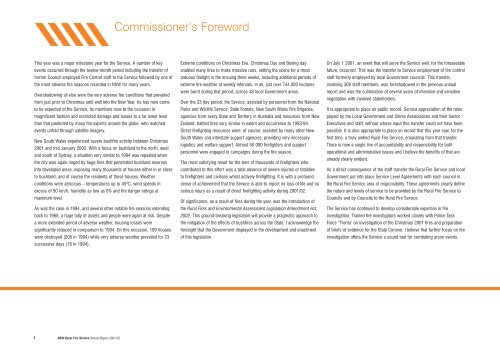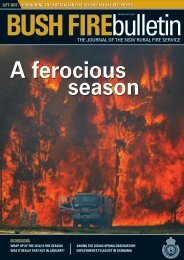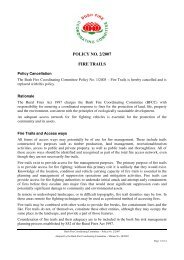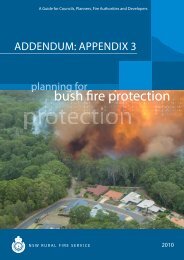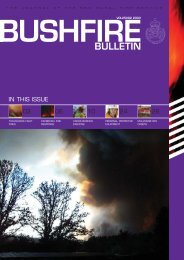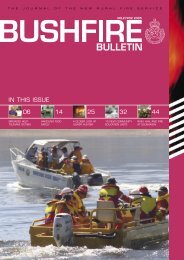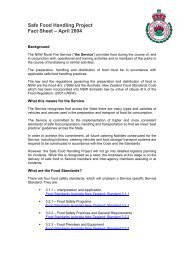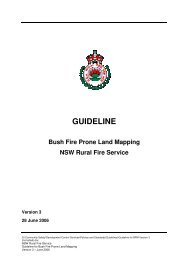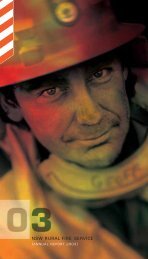Volunteer Professionals - NSW Rural Fire Service - NSW Government
Volunteer Professionals - NSW Rural Fire Service - NSW Government
Volunteer Professionals - NSW Rural Fire Service - NSW Government
You also want an ePaper? Increase the reach of your titles
YUMPU automatically turns print PDFs into web optimized ePapers that Google loves.
Commissioner’s Foreword<br />
This year was a major milestone year for the <strong>Service</strong>. A number of key<br />
events occurred through the twelve-month period including the transfer of<br />
former Council employed <strong>Fire</strong> Control staff to the <strong>Service</strong> followed by one of<br />
the most adverse fire seasons recorded in <strong>NSW</strong> for many years.<br />
Overshadowing all else were the very adverse fire conditions that prevailed<br />
from just prior to Christmas until well into the New Year. As has now come<br />
to be expected of the <strong>Service</strong>, its members rose to the occasion in<br />
magnificent fashion and restricted damage and losses to a far lower level<br />
than that predicted by many fire experts around the globe, who watched<br />
events unfold through satellite imagery.<br />
New South Wales experienced severe bushfire activity between Christmas<br />
2001 and mid January 2002. With a focus on bushland to the north, west<br />
and south of Sydney, a situation very similar to 1994 was repeated when<br />
the city was again ringed by huge fires that penetrated bushland reserves<br />
into developed areas, exposing many thousands of houses either in or close<br />
to bushland, and of course the residents of those houses. Weather<br />
conditions were atrocious – temperatures up to 45ºC, wind speeds in<br />
excess of 90 km/h, humidity as low as 6% and fire danger ratings at<br />
maximum level.<br />
As was the case in 1994, and several other notable fire seasons extending<br />
back to 1968, a huge tally of assets and people were again at risk. Despite<br />
a more extended period of adverse weather, housing losses were<br />
significantly reduced in comparison to 1994. On this occasion, 109 houses<br />
were destroyed (205 in 1994) while very adverse weather prevailed for 23<br />
successive days (16 in 1994).<br />
Extreme conditions on Christmas Eve, Christmas Day and Boxing day<br />
enabled many fires to make massive runs, setting the scene for a most<br />
arduous firelight in the ensuing three weeks, including additional periods of<br />
extreme fire weather at weekly intervals. In all, just over 744,000 hectares<br />
were burnt during that period, across 48 local <strong>Government</strong> areas.<br />
Over the 23 day period, the <strong>Service</strong>, assisted by personnel from the National<br />
Parks and Wildlife <strong>Service</strong>, State Forests, New South Wales <strong>Fire</strong> Brigades,<br />
agencies from every State and Territory in Australia and resources from New<br />
Zealand, battled fires very similar in extent and occurrence to 1993/94.<br />
Direct firefighting resources were, of course, assisted by many other New<br />
South Wales and interstate support agencies, providing very necessary<br />
logistics and welfare support. Almost 50 000 firefighters and support<br />
personnel were engaged in campaigns during the fire season.<br />
The most satisfying result for the tens of thousands of firefighters who<br />
contributed to this effort was a total absence of severe injuries or fatalities<br />
to firefighters and civilians whilst actively firefighting. It is with a profound<br />
sense of achievement that the <strong>Service</strong> is able to report no loss of life and no<br />
serious injury as a result of direct firefighting activity during 2001/02.<br />
Of significance, as a result of fires during the year, was the introduction of<br />
the <strong>Rural</strong> <strong>Fire</strong>s and Environmental Assessment Legislation Amendment Act,<br />
2002. This ground-breaking legislation will provide a pragmatic approach to<br />
the mitigation of the effects of bushfires across the State. I acknowledge the<br />
foresight that the <strong>Government</strong> displayed in the development and enactment<br />
of this legislation.<br />
On July 1 2001, an event that will serve the <strong>Service</strong> well, for the foreseeable<br />
future, occurred. This was the transfer to <strong>Service</strong> employment of fire control<br />
staff formerly employed by local <strong>Government</strong> councils. This transfer,<br />
involving 308 staff members, was foreshadowed in the previous annual<br />
report and was the culmination of several years of intensive and sensitive<br />
negotiation with involved stakeholders.<br />
It is appropriate to place on public record, <strong>Service</strong> appreciation of the roles<br />
played by the Local <strong>Government</strong> and Shires Associations and their Senior<br />
Executives and staff, without whose input this transfer could not have been<br />
possible. It is also appropriate to place on record that this year saw, for the<br />
first time, a truly unified <strong>Rural</strong> <strong>Fire</strong> <strong>Service</strong>, emanating from that transfer.<br />
There is now a single line of accountability and responsibility for both<br />
operational and administrative issues and I believe the benefits of that are<br />
already clearly evident.<br />
As a direct consequence of the staff transfer the <strong>Rural</strong> <strong>Fire</strong> <strong>Service</strong> and local<br />
<strong>Government</strong> put into place <strong>Service</strong> Level Agreements with each council in<br />
the <strong>Rural</strong> <strong>Fire</strong> <strong>Service</strong> area of responsibility. These agreements clearly define<br />
the nature and levels of service to be provided by the <strong>Rural</strong> <strong>Fire</strong> <strong>Service</strong> to<br />
Councils and by Councils to the <strong>Rural</strong> <strong>Fire</strong> <strong>Service</strong>.<br />
The <strong>Service</strong> has continued to develop considerable expertise in fire<br />
investigation. Trained fire investigators worked closely with Police Task<br />
Force “Tronto’ on investigation of the Christmas 2001 fires and preparation<br />
of briefs of evidence for the State Coroner. I believe that further focus on fire<br />
investigation offers the <strong>Service</strong> a sound tool for combating arson events.<br />
2<br />
<strong>NSW</strong> <strong>Rural</strong> <strong>Fire</strong> <strong>Service</strong> Annual Report 2001/02


